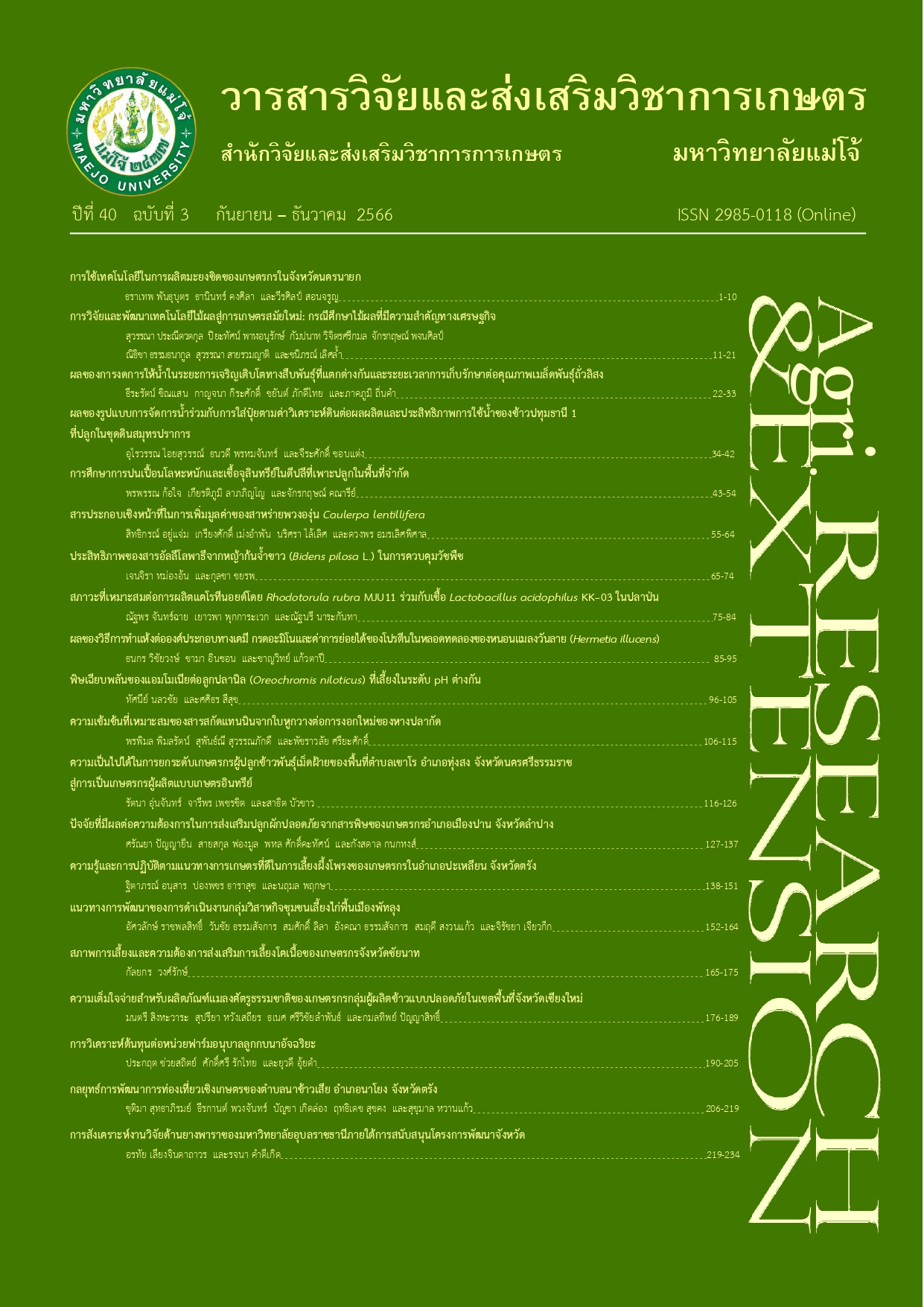ความเข้มข้นที่เหมาะสมของสารสกัดแทนนินจากใบหูกวางต่อการงอกใหม่ของหางปลากัด
คำสำคัญ:
แทนนิน, ใบหูกวาง , การงอกใหม่ของหาง , ความเข้มข้น, ปลากัดบทคัดย่อ
การศึกษานี้มีวัตถุประสงค์เพื่อหาความเข้มข้นที่เหมาะสมของสารแทนนินที่สกัดจากใบหูกวางต่อการงอกใหม่ของหางปลากัด โดยแบ่งการศึกษาออกเป็น 2 การทดลอง คือ การทดลองที่ 1 ศึกษาความเข้มข้นที่เหมาะสมของสารสกัดแทนนินจากใบหูกวางต่อการงอกใหม่ของหางปลากัด โดยการเลี้ยงปลากัดที่ผ่านการตัดครีบหางในสารสกัดแทนนินจากใบหูกวางที่ระดับความเข้มข้นของแทนนิน คือ 0, 5, 10, 20 และ 40 ppm ความเข้มข้นละ 3 ซ้ำ เป็นระยะเวลา 5 สัปดาห์ ผลการศึกษาพบว่า ปลากัดชุดที่แช่ในสารสกัดแทนนินความเข้มข้น 40 ppm มีอัตราการงอกใหม่ของหางเร็วที่สุดอย่างมีนัยสำคัญทางสถิติ (p<0.05) กับชุดการทดลองอื่นๆ การทดลองที่ 2 ศึกษาการใช้สารสกัดแทนนินจากใบหูกวางที่ระดับความเข้มข้นของแทนนิน คือ 0, 5, 10, 20 และ 40 ppm ความเข้มข้นละ 3 ซ้ำ ร่วมกับเกลือแกง 1 เปอร์เซ็นต์ ต่ออัตราการงอกใหม่ของหางปลากัด ผลการศึกษาพบว่า เมื่อใช้เกลือแกง 1 เปอร์เซ็นต์ ร่วมกับสารสกัดแทนนินจากใบหูกวางที่ความเข้มข้นของแทนนิน 40 ppm อัตราการงอกของหางปลากัดมีค่าสูงที่สุด (100 เปอร์เซ็นต์ ภายใน 3 สัปดาห์) แตกต่างอย่างมีนัยสำคัญทางสถิติ (p<0.05) เมื่อเปรียบเทียบกับชุดควบคุม ดังนั้น ความเข้มข้นที่เหมาะสมของสารแทนนินจากใบหูกวางที่มีผลทำให้หางปลากัด งอกใหม่ได้เร็วที่สุด คือ ความเข้มข้น 40 ppm และควรใช้สารสกัดร่วมกับเกลือแกง 1 เปอร์เซ็นต์
เอกสารอ้างอิง
Association of Official Analytical Chemists (AOAC). 1990. Official Methods of Analysis. 15thedition. Washington. DC.: Association of Official Analytical Chemist. 1298 p.
Chansue, N. 2006. Efficacies of dry Indian almond leaf (Terminalia catappa) and Andrographis paniculata (Burn.F) Wall. ex Nees extract on tail growth and hematocrit of fancy carp (Cyprinus carpio Linn.). Journal of Thai Veterinary Medical Association Under the Royal Patronage 57(2): 52-62. [in Thai]
Chanratchakool, P., C. Limsuwan and S. Chinabut. 1988. Effects of Sodium Chloride on Survival Rate and Plasma Electrolytes of Walking Catfish (Clarias batrachus) from Transportation. pp. 393-407. In Proceedings of the 26th Kasetsart University Annual Conference. Bangkok: Kasetsart University. [in Thai]
Chyau, C.C., S.Y. Tsai, P.T. Ko and J.L. Mau. 2002. Antioxidant properties of solvent extracts from Terminalia catappa leaves. Food Chem. 78(4): 483-488.
Goun, E., G. Cunningham, D. Chu, C. Nguyen and D. Miles. 2003. Antibacterial and antifungal activity of Indonesian ethnomedical plants. Fitoterapia 74(6): 592-596.
Harari, J. 1996. Wound Healing. Small Animal Surgery. Baltimore: Williams & Wilkins. 408 p.
Ko-sing, S., P. Ponza, K. Pisamayarom, P. Sangjun and S. Ponza. 2018. Application of India almond (Terminalia catappa L.) leaves extract powder to inhibit bacteria (Aeromonas hydrophila) in Siamese fighting fish (Betta splendens Regan). Agricultural Science Journal 49:3(Suppl.): 85-91. [in Thai]
Mahasawasde, S. and C. Limsuwan. 1989. Relationships between plasma electrolytes and survival rate of juvenile walking catfish (Clarias batrachus Linn.) during transportation. Kasetsart Journal (Natural Science) 23(4): 358-363. [in Thai]
Pimolrat, P., N. Whangchai, S. Suwanpakdee and P. Sriyasak. 2018. Extraction Method and Efficiency of Indian Almond Leave (Terminalia catappa) Extract on Amount of Ammonia Reducing in Water. pp. 722-728. In Proceedings of the 3rd National Conference on Informatics, Agriculture, Management, Business Administration, Engineering, Science and Technology (Oral). Chumphon: KMITL, Prince of Chumphon Campus. [in Thai]
Ponpornpisit, A., J. Tangtrongpiros, N. Chansue, W. Koeypudsa, N. Paphavasit and M. Endo. 2006. The Study of Indian Almond Leaves (Terminalia catappa L.) on Siamese Fighting Fish (Betta splendens) and Guppy (Poecilia reticulata) Diseases Treatment. 121 p. In Research Report. Bangkok: Chulalongkorn University. [in Thai]
Purivirojkul, W. and N. Areechon. 2006. Antibacterial Activity and Toxicity of Indian Almond (Terminalia catappa) Extract in Siamese Fighting Fish (Betta splendens Regan). pp. 109-116. In Proceedings of 44th Kasetsart University Annual Conference: Fisheries (Oral). Bangkok: Kasetsart University. [in Thai]
Puttamat, S. and W. Suwannasarn. 2007. Study of Chemical Composition of Dried Leaves of Indian Almond (Terminalia catappa L.) and Its Effect on Water Quality and Anti-aquatic Bacteria Activity. pp. 579-585. In Proceedings of 45th Kasetsart University Annual Conference: Plants (Oral). Bangkok: Kasetsart University. [in Thai]
Rajamangala University of Technology Suvarnabhum Research and Development Institute (RUTSRDI). 2015. Case study of surgery fish. [Online]. Available https://research.rmutsb.ac.th/fullpaper/2558/2558240240422.pdf (January 1, 2021). [in Thai]
Schâperclaus, W. 1986. Hematological and serological techniques. pp. 71-108. In Schâperclaus, W., H. Kulow and K. Scheckenbach (eds.). Fish Diseases Vol.1. Berlin: Fischkrankheiten, Academic-Verlag.
Thongprajukaew, K. 2013. Biology of Siamese fighting fish (Betta splendens Regan, 1910). KKU Science Journal 41(1): 1-15. [in Thai]
ดาวน์โหลด
เผยแพร่แล้ว
รูปแบบการอ้างอิง
ฉบับ
ประเภทบทความ
สัญญาอนุญาต
ลิขสิทธิ์ (c) 2023 วารสารวิจัยและส่งเสริมวิชาการเกษตร

อนุญาตภายใต้เงื่อนไข Creative Commons Attribution-NonCommercial-NoDerivatives 4.0 International License.
บทความนี้ได้รับการเผยแพร่ภายใต้สัญญาอนุญาต Creative Commons Attribution-NonCommercial-NoDerivatives 4.0 International (CC BY-NC-ND 4.0) ซึ่งอนุญาตให้ผู้อื่นสามารถแชร์บทความได้โดยให้เครดิตผู้เขียนและห้ามนำไปใช้เพื่อการค้าหรือดัดแปลง หากต้องการใช้งานซ้ำในลักษณะอื่น ๆ หรือการเผยแพร่ซ้ำ จำเป็นต้องได้รับอนุญาตจากวารสาร





